February 14 - 20, 2016: Issue 251
THE WHITE PASS AND YUKON ROUTE
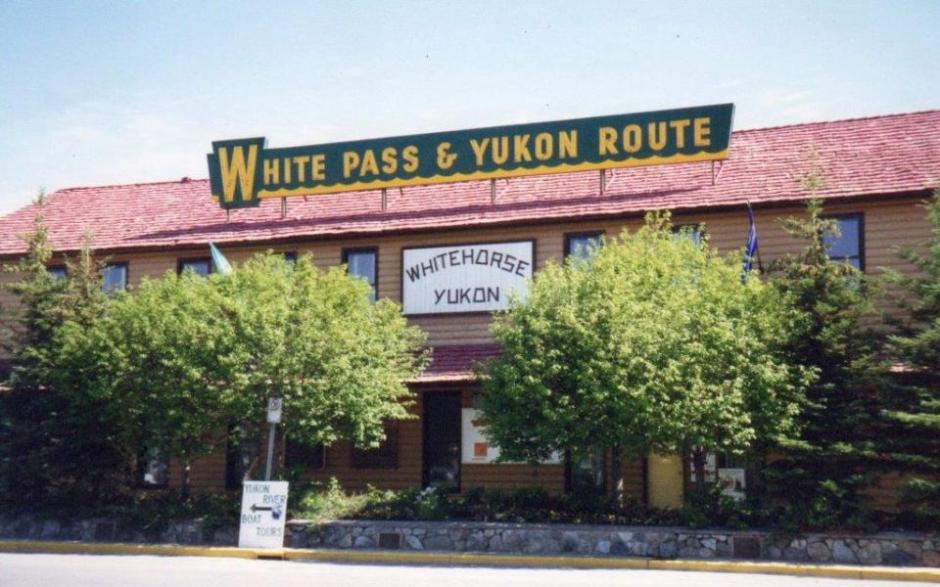
Station at Whitehorse, Yukon Territory, Canada in June, 1998.
THE WHITE PASS AND YUKON ROUTE
By George Repin
On August 17, 1896 George Carmack and two Indian companions, Shookum Jim and Dawson Charlie, found gold in Bonanza Creek in the Klondike area of the Yukon Territory. Although the few flakes of gold were only just enough to fill the empty cartridge of a Winchester rifle, news of the discovery reaching Seattle and San Francisco, triggered the Klondike Gold Rush. With the United States in an economic depression tens of thousands headed north hoping to find their fortune, arriving by steamer in Skagway. Here they were still nearly 600 miles from the area where gold had been found, with a mountain range between them and the inland water ways which they hoped would take them the rest of the way.
Canadian authorities, concerned to ensure that prospectors did not starve to death, stipulated that each should take one ton of food supplies – this being in addition to tools, tents and their other needs.
There were two routes over the mountain – the shorter, steeper Chilkoot Trail – up the Golden Stairs – on which a man might have to make 35 trips up and down to get his gear to the top – and the longer, less steep White Pass Trail on which pack horses could be used. Overburdened horses died on this route in large numbers. According to Jack London “they died like mosquitoes in the first frost”.
Both routes over the mountain led to the interior lake system 40 miles inland from Skagway. Here, with 550 miles still ahead of them, the hopeful prospectors cut down trees to build boats and rafts to carry them to the Yukon River and the gold fields.
In early 1898 two men, Sir Thomas Tancred representing a group of British financiers and Michael J. Heney a Canadian Railway contractor met by chance in a hotel bar. Each man believed that building a railway over the mountain was feasible and, after talking all night, decided to go ahead together. The White Pass & Yukon Railroad Company was organised in April 1898 and construction began on May 28, 1898.
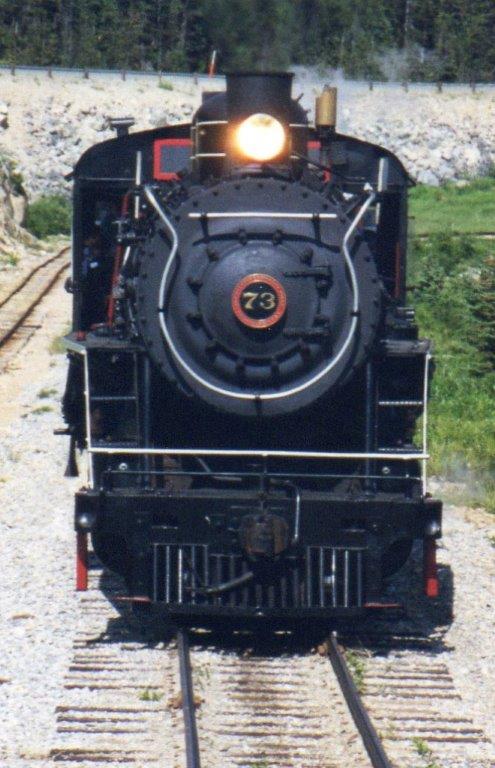
Steam Engine No. 73 - a restored 1947 Baldwin locomotive which escorted trains to the edge of town
It was decided to build a narrow gauge railroad for two reasons:
• The tracks of a narrow gauge railway are three feet apart so they need only a 10 foot wide bed – meaning less rock to blast and lower construction costs.
• A narrow gauge track requires a smaller turning radius than the four feet eight and a half inches of standard gauge – making it easier to negotiate the tight curves anticipated on the White Pass.
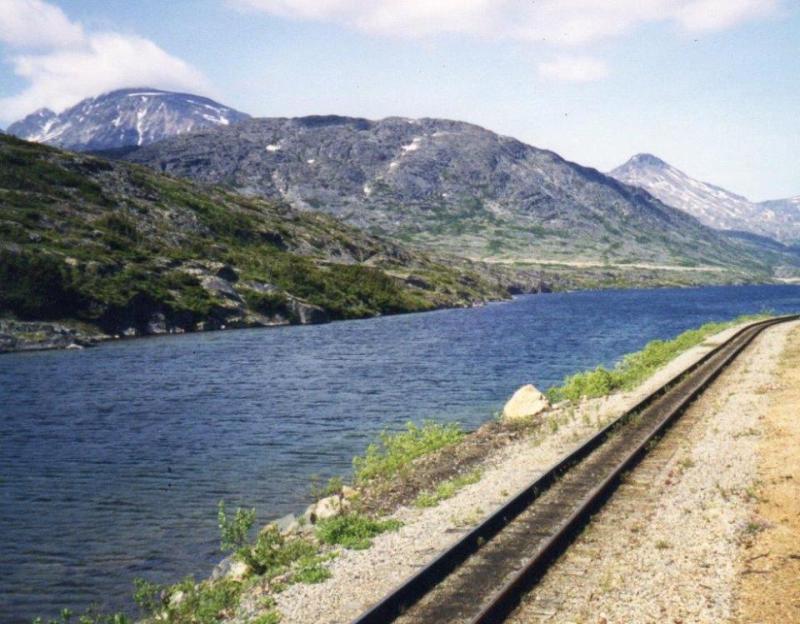
Narrow gauge tracks - rails 3 feet apart
The construction of the railway was a superhuman feat. The railroad climbed from sea level to 2,865 feet at the summit, with grades of 3.9%. Heavy snow and temperatures as low as 60 degrees below zero hampered the work.
The summit of White Pass was reached on 18 February, 1899. While the southern gang blasted its way north through the pass a northern crew worked south from Whitehorse. The two gangs met on 29 July, 1900.
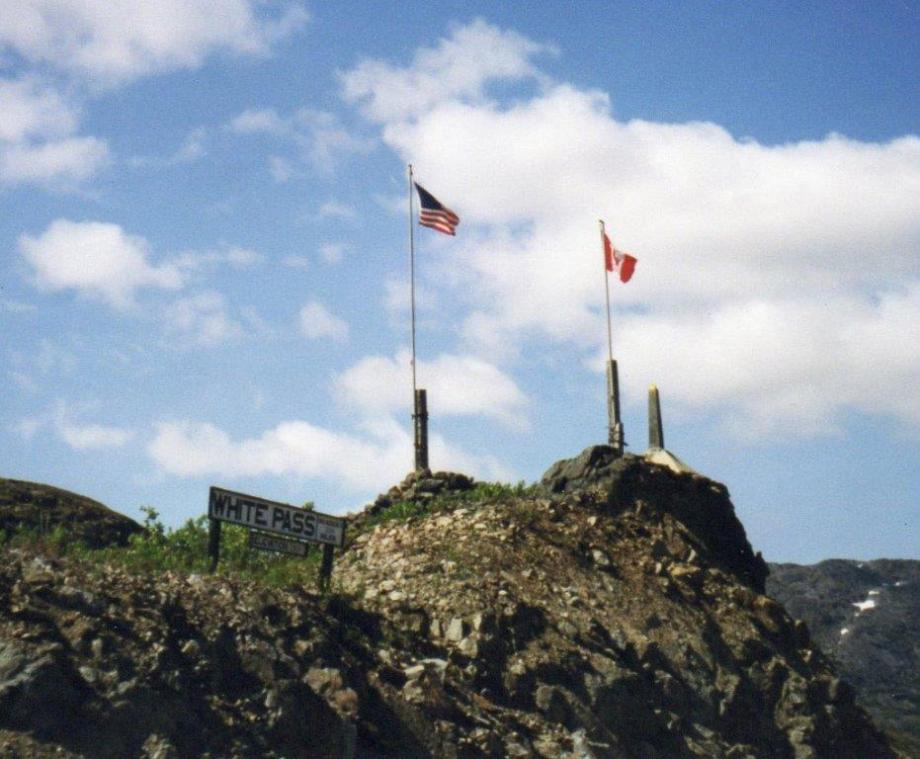
White Pass - at the border of Yukon Territory and Alaska
Over the years the railway carried passengers and freight to the Yukon, supplied materials for the construction of the U.S. Army’s Alaska Highway and was recognised internationally as an excursion train.
Steam locomotives gave way to diesel electric locomotives in 1954.
When world metal prices fell in 1982 Yukon mines closed. The railroad became non-viable and stopped running. However, with a rapid increase in cruise passengers arriving in Skagway the railroad was reopened in 1988 purely as an excursion train to carry tourists.
The photographs accompanying this article were taken during a trip on the train from Whitehorse in the Yukon Territory, Canada to Skagway, Alaska in 1998.
(Footnote: The film for which Charles Chaplin declared that he most wanted to be remembered was a poignant silent film The Gold Rush made in 1925 and re-released in 1942.)
The Gold Rush (1925)
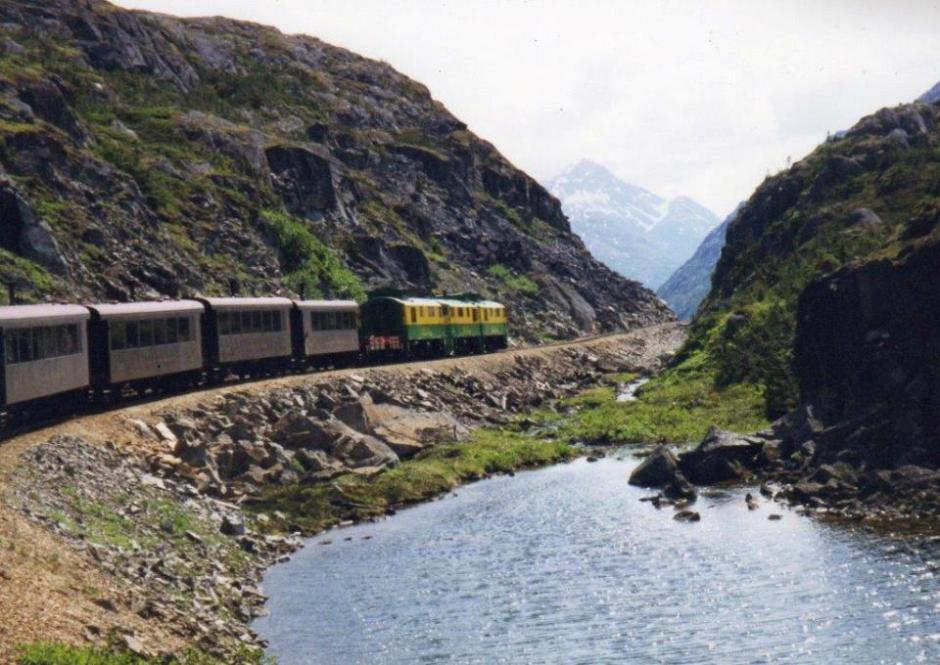
The train skirting a lake.
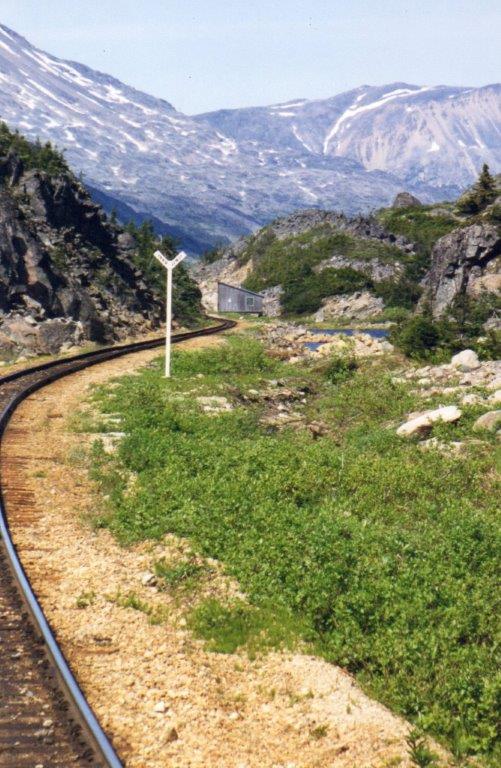
A cabin by the track available for hire from the US Forest Service.
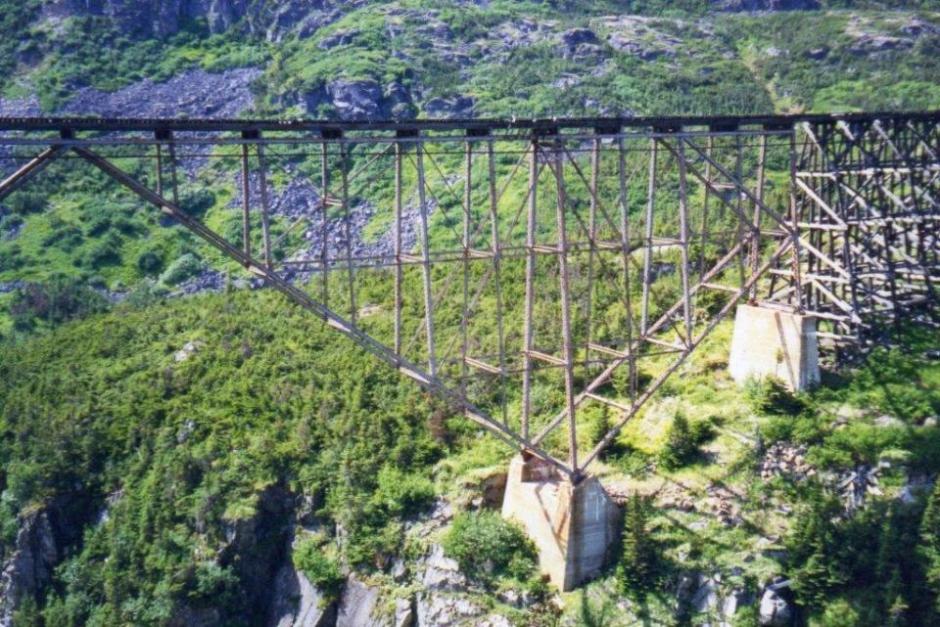
Bridge over Glacier Gorge.
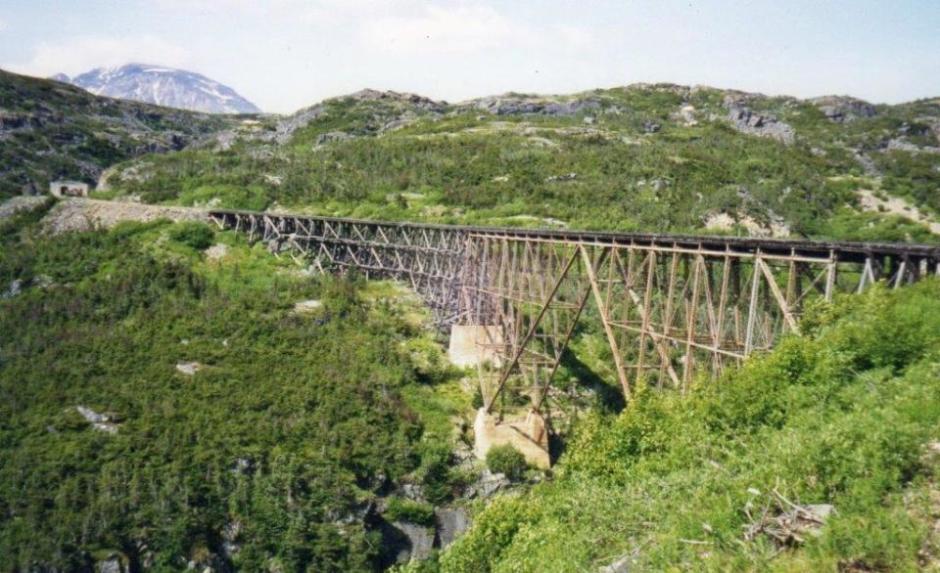
Bridge over Glacier Gorge with line entering the tunnel under Tunnel Mountain.
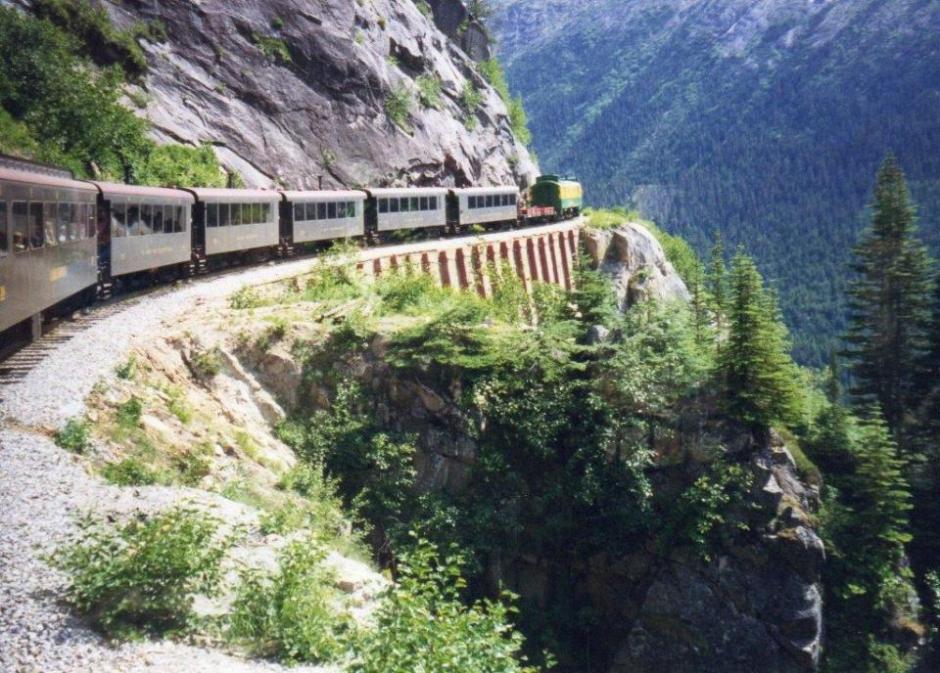
Hugging the mountainside along the face of Slippery Rock.
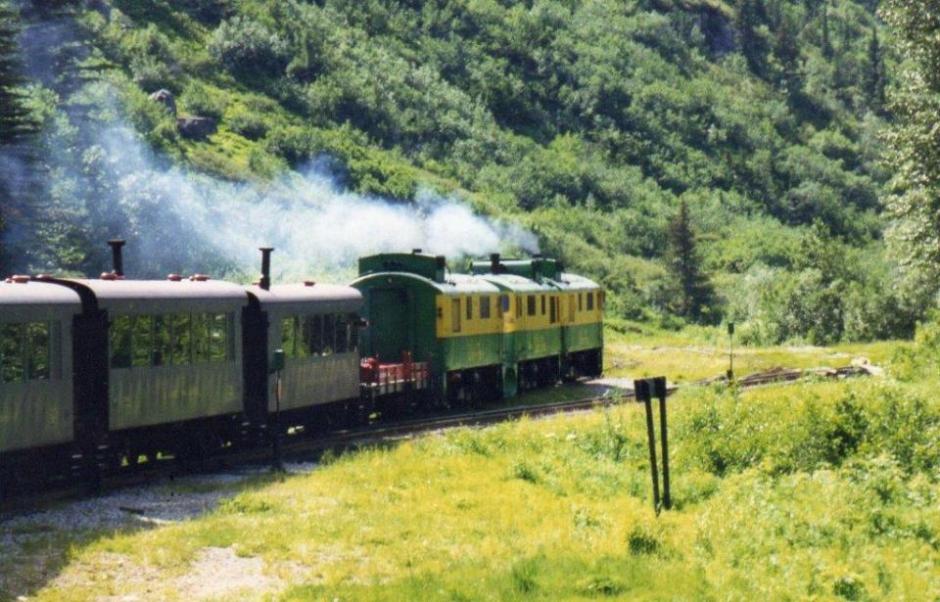
In the valley approaching Skagway.
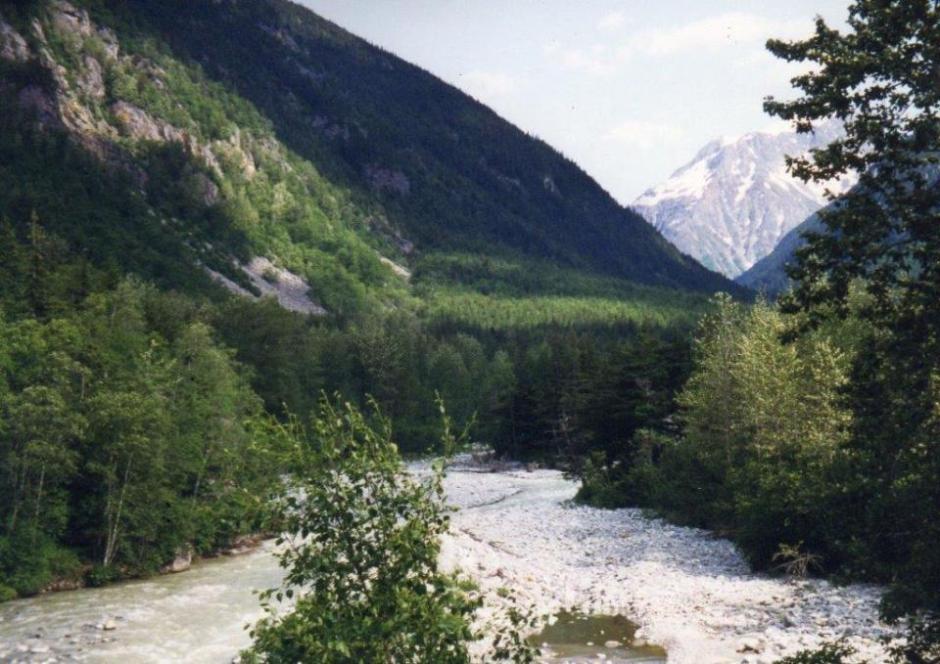
Crossing a stream
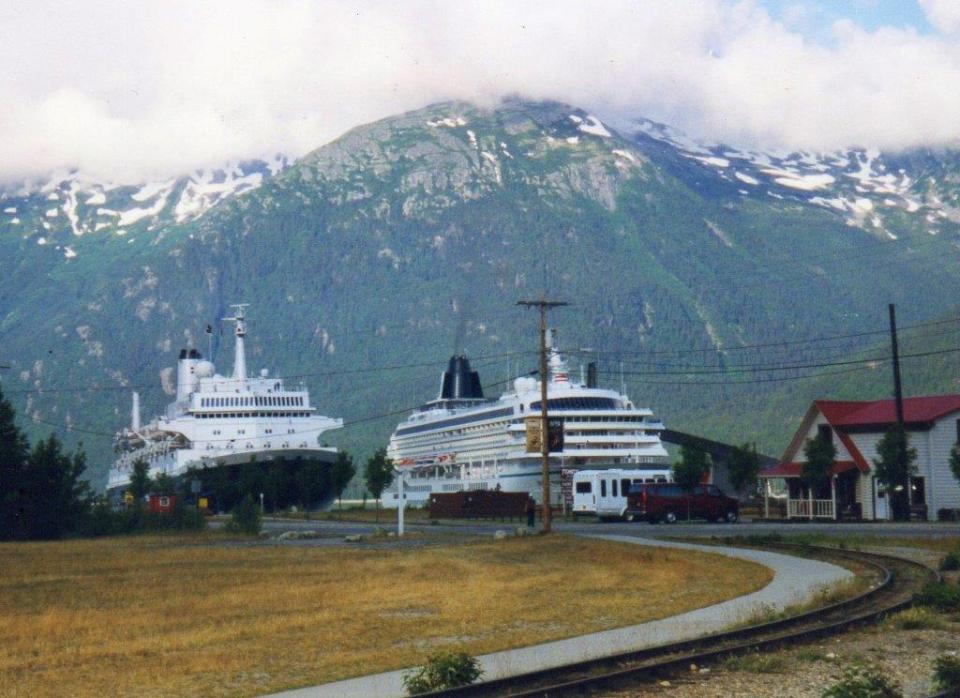
Ships berthed at Skagway.
Previous Reflections by George Repin
The Nineteen Thirties Remembering Rowe Street The Sydney Push Saturday Night at the Movies Shooting Through Like A Bondi Tram A Stop On The Road To Canberra City Department Stores - Gone and Mostly Forgotten An Australian Icon - thanks to Billy Hughes Crossing The Pacific in the 1930s Hill End The Paragon at Katoomba Seafood In Sydney How Far From Sydney? Cockatoo Island Over The Years The Seagull at the Melbourne Festival in 1991 Busby's Bore The Trocadero In Sydney Cahill's restaurants Medical Pioneers in Australian Wine Making Pedal Power and the Royal Flying Doctor Service Pambula and the Charles Darwin Connection Gloucester and the Barrington Tops A Millenium Apart Have You Stopped to Look? Gulgong Il Porcellino Olympia Durham Hall Sargent's Tea Rooms Pie Shops and Street Photographers The Ballet Russes and Their Friends in Australia Hotels at Bondi Alma Ata Conference - 1978 Keukenhof - 1954 The Lands Department Building and Yellowblock Sandstone The Goroka Show - 1958 A Gem On The Quay Staffa The Matson Line and Keepsake Menus Kokeshi Dolls The Coal Mine At Balmain The Hyde Park Barracks The Changing Faces Of Sydney From Pounds and Pence to Dollars and Cents Nell Tritton and Alexander Kerensky Making A Difference In Ethiopia William Balmain J C Bendrodt and Princes Restaurant Azzalin Orlando Romano and Romano's Restaurant Waldheim Alcohol in Restaurants Before 1955 King Island Kelp The Mercury Theatre Around Angkor - 1963 Angkor Wat 1963 Costumes From the Ballets Russe Clifton at Kirribilli Chairman Mao's Personal Physician The Toby Tavern The MoKa at Kings Cross The Oceaographic Museum in Monaco The Island of Elba Russian Fairy Tale Plates Meteora Souda Bay War Cemetery Barrow, Alaska Cloisonné Tripitaka Koreana Minshuku The Third Man Photographs and Memories Not A Chagall! Did You Listen? Did You Ask? Napier (Ahuriri, Maori) New Zealand Borobudur Ggantija Temples Plumes and Pearlshells Murano University of Padua Ancient Puebloe Peoples - The Anasazi Pula The Gondolas of Venice Cinque Terre Visiting the Iban David The Living Desert Bryce Canyon National Park Aphrodisias The Divine Comedy Caodaism Sapa and local Hill People A Few Children Cappadocia Symi Jean-Marie Tjibaou Cultural Centre Aboriginal Rock Art on Bigge Island ANZAC Cove (Ari Burnu) 25 April, 1997 Hotere Garden Oputae Children of the Trobriand Islands Page Park Market - Rabaul Rabual Kotor, Montenegro Galleries of Photographs I Lascaux Galleries of Photographs II The Cathedral of St. James – Šibenik, Croatia Ivan Meštrović - Sculptor Delphi Gallery of Photographs III The Handicrafts of Chiang Mai Raft Point San Simeon - "Hearst Castle" Floriade - The Netherlands - 1982 Russian New Year Mycenae "Flightseeing" Out Of Anchorage Alaska
Copyright George Repin 2016. All Rights Reserved.